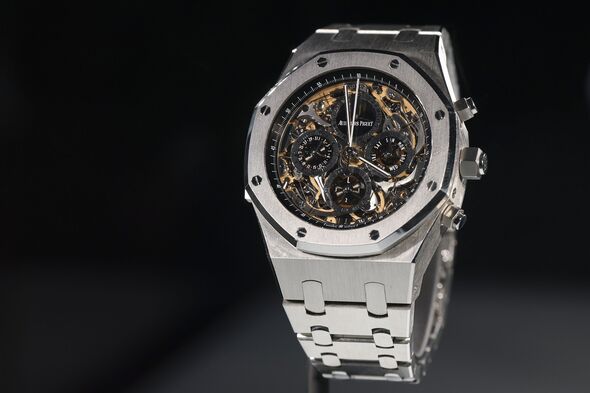Lifestyle
Expert Reveals How to Spot Fake Luxury Watches as Demand Soars

As the demand for luxury watches rises, concerns about counterfeit timepieces have intensified. Mark Baldwin, a seasoned expert from Watches2U, has shared vital insights on how consumers can identify fake watches, which have become increasingly sophisticated and challenging to detect.
With over four decades in the watch industry, Baldwin highlights the dangers of purchasing counterfeit luxury items. “In the past, fakes were really easy to identify. While some obvious imitations are still on the market, high-end counterfeits are much harder to spot,” he explains. The allure of brands such as Rolex, Omega, and Tag Heuer makes them prime targets for fraudsters. Baldwin warns that consumers may unknowingly pay full price for a counterfeit that offers little in terms of quality or safety.
Baldwin points out the dark implications of the counterfeit trade, stating, “Some people think buying a counterfeit item is harmless, but it actually funds organised crime.” He emphasizes the importance of vigilance, especially as luxury watches are often one of the most expensive purchases in a person’s life.
Key Indicators of Authenticity
To help buyers navigate this complex market, Baldwin outlines eight critical signs to look for when assessing a luxury watch.
One of the most noticeable indicators is the presence of spelling errors on the dial. “An off-centre logo is also a clear indication of a fake,” he advises. Consumers should closely examine the colours and fonts on the watch face to ensure they match the established standards of the brand.
In addition to appearance, the quality of materials used is crucial. Baldwin notes, “With a genuine luxury watch, the metal strap links should move freely. If the links are stiff or awkward to manoeuvre, this could be a warning sign.” The functionality of the watch is another important factor; features like subdials or helium release functions in diving watches should operate correctly.
Weight is another key element. A genuine luxury watch should feel substantial due to its high-quality materials. Baldwin cautions, “An item that’s as light as a feather should be ringing alarm bells.”
Listen for Quality and Check Packaging
A Swiss timepiece is typically quiet, so prospective buyers should listen closely. “If you can hear loud ticking, this is a strong indication your watch might not be authentic. For example, Rolex rarely has a Quartz movement. The movement in your Rolex should be mechanical, sweeping around the face rather than ticking,” Baldwin explains.
Quality watches also come with premium packaging and relevant paperwork. “If your chosen watch comes with little to no packaging, then be cautious. Examine the box, warranty cards, and user manual,” he advises. Documentation or certificates confirming the watch’s legitimacy is essential. Baldwin warns that if this is missing, it could indicate a counterfeit.
For those uncertain about the authenticity of a watch, Baldwin suggests consulting an authorised expert. “Always trust your gut. If a deal feels too good to be true, it probably is,” he concludes.
As counterfeit luxury watches become more prevalent, awareness and education are paramount. By following Baldwin’s advice, consumers can better protect themselves against the risks associated with fake timepieces, ensuring that their investment is genuine.
-

 Health3 months ago
Health3 months agoNeurologist Warns Excessive Use of Supplements Can Harm Brain
-

 Health4 months ago
Health4 months agoFiona Phillips’ Husband Shares Heartfelt Update on Her Alzheimer’s Journey
-

 Science2 months ago
Science2 months agoBrian Cox Addresses Claims of Alien Probe in 3I/ATLAS Discovery
-

 Science2 months ago
Science2 months agoNASA Investigates Unusual Comet 3I/ATLAS; New Findings Emerge
-

 Science2 months ago
Science2 months agoScientists Examine 3I/ATLAS: Alien Artifact or Cosmic Oddity?
-

 Entertainment2 months ago
Entertainment2 months agoLewis Cope Addresses Accusations of Dance Training Advantage
-

 Entertainment5 months ago
Entertainment5 months agoKerry Katona Discusses Future Baby Plans and Brian McFadden’s Wedding
-

 Science2 months ago
Science2 months agoNASA Investigates Speedy Object 3I/ATLAS, Sparking Speculation
-

 Entertainment5 months ago
Entertainment5 months agoEmmerdale Faces Tension as Dylan and April’s Lives Hang in the Balance
-

 World3 months ago
World3 months agoCole Palmer’s Cryptic Message to Kobbie Mainoo Following Loan Talks
-

 World4 weeks ago
World4 weeks agoBailey and Rebecca Announce Heartbreaking Split After MAFS Reunion
-

 Science2 months ago
Science2 months agoNASA Scientists Explore Origins of 3I/ATLAS, a Fast-Moving Visitor









